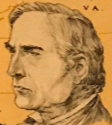Samuel Mason | |
|---|---|
 No known portrait of Samuel Mason exists from life. A likeness from his physical description mentioned in historical records.[1] | |
| Born | Samuel Ross Mason November 8, 1739 |
| Died | 1803 (aged 63–64) |
| Cause of death | Murder by gunshot wound or tomahawk |
| Nationality | American |
| Other names | Sam Mason, Mason, Samuel Meason, Meason, Captain Mason, Ensign Mason, Squire Mason, Mason of the Woods, Wilson, Bully Wilson |
| Occupation(s) | Horse thief, soldier, state militia officer, frontiersman, associate judge, tavern keeper, burglar, bandit, justice of the peace, criminal gang leader, river pirate |
| Employer(s) | Virginia state government, self-employed |
| Spouse | Rosanna or Rosannah Dorsey |
| Children | 6[2] |
| Relatives | George Mason (grandfather) |
| Military career | |
| Allegiance | |
| Service | Virginia State Forces |
| Years of service | 1777–1779 |
| Rank | Captain |
| Unit | Ohio County Militia |
| Commands | Captain Samuel Mason's Company |
| Battles / wars | |
| Signature | |
 | |
Samuel Ross Mason[a] (November 8, 1739 – 1803), was an American Revolutionary War veteran, Virginia militia captain, justice of the peace, frontier leader, and later, a figure associated with river piracy and highway robbery. He is best known as the leader of the Mason Gang, a notorious group active along the lower Ohio River and Mississippi Rivers in the late 18th and early 19th centuries. Mason is most famously linked to the Cave-in-Rock area, a notorious river pirate stronghold along the Ohio River.
Born in Virginia, Mason served in the Revolutionary War, notably on the western frontier. Following the war, he became involved in the region's lawlessness, eventually establishing himself as a prominent figure in outlaw circles. His gang was involved in various illegal activities, including piracy and robbery, and was associated with notorious sites such as Red Banks, Cave-in-Rock, Stack Island, and the Natchez Trace.
Mason’s motivations have been the subject of much speculation, since personal anecdotes and firsthand accounts of his life are scarce to nonexistent. While his criminal activities are well-documented, it has been suggested that his actions may have been driven by broader political and economic motivations. In particular, his later resistance to federal authority, particularly following the Whiskey Rebellion of 1791–1794, has led some to interpret his post-war activities as part of a broader anti-government sentiment. This interpretation presents Mason as not merely a criminal, but potentially a figure of resistance to what he perceived as an overreaching government, particularly in the post-Revolutionary War era. However, his activities are also seen by others primarily as self-serving criminal ventures, and his role in the outlaw world of the frontier continues to shape his legacy.
- ^ Rothert, Otto A. (1924). "The outlaws of Cave-in-Rock : historical accounts of the famous highwaymen and river pirates who operated in pioneer days upon the Ohio and Mississippi Rivers and over the old Natchez trace". Cleveland, OH: Arthur H. Clark. pp. 244–245.
- ^ "Bill-Dupire - User Trees - Genealogy.com". www.genealogy.com.
Cite error: There are <ref group=lower-alpha> tags or {{efn}} templates on this page, but the references will not show without a {{reflist|group=lower-alpha}} template or {{notelist}} template (see the help page).
